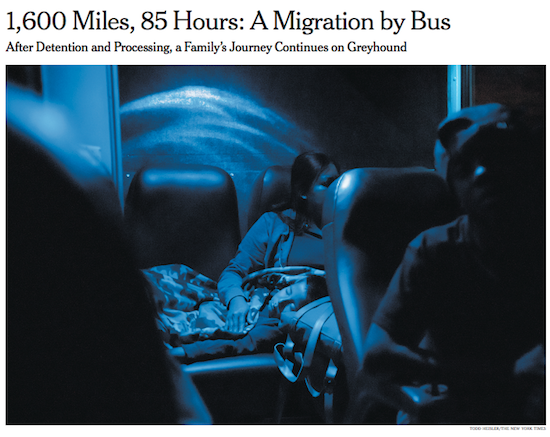Leave it the New York Times to insult Americans on Memorial Day by featuring an enormous sob story of an illegal alien family being transported through America to their destination. By comparison, other liberal papers like the Washington Post and Los Angeles Times front-paged patriotic stories of remembrance suitable to the occasion.
Below, highlighting a Guatemalan moocher family was more important to the New York Times [1] than honoring American military patriots lost in war defending this nation on the day remembering them.

And yes, foreign kiddies are arriving by the thousands, who will strain local schools with their inability to speak English, health concerns and needs for special treatment. Local communities will be forced to either raise taxes or cut services to citizen students.
Actually, the family profiled by the Times should complain that they had to ride the bus: the Associated Press reported that DHS has been flying aliens to various American cities [2].
Who knew open borders now include transport unblocked by the US government into the interior? This is not how I imagined the Trump Presidency.
The Times story was reprinted elsewhere, linked below:
1,600 miles, 85 hours: A migrant family takes a Greyhound across America [3], by Miriam Jordan, New York Times, May 27, 2019
DALLAS — By the time it pulled into Dallas, the bus from Arizona was two hours and 47 minutes late. It had left Phoenix overbooked, turned away passengers with tickets in Tucson, rolled through El Paso at 2am and finally disgorged its human cargo — a busload of exhausted migrants, mostly from Central America — shortly before dusk the next day.
A sign in the Greyhound bus terminal listed the ongoing routes that were already facing delayed departures: San Antonio, Los Angeles, Houston, Detroit, Atlanta, Brownsville. All of them would be late; most of them were full. Those who had missed their connections would need to wait in line, an agent announced, as the disembarking passengers — many of them with no food, no money and no possessions beyond what was in their slim backpacks — listened in stunned silence.
“My God, we are going to have to spend two nights here,” Zuleima Lopez, recently arrived from Guatemala with her husband and three children, murmured as she surveyed the ragged tableau inside the terminal. Refuse had long before overfilled the available trash bins, and a rank odour wafted out from the restrooms. Mothers, fathers and children huddled together on scraps of cardboard, atop tattered blankets and splayed jackets. Feverish babies with runny noses fussed in their mothers’ arms.
At one end of the station, several passengers jostled for $7.50 meal vouchers — 19 cents less than the cheapest cheeseburger combo — until, halfway through the line, the agent announced that there were no more vouchers.
A Greyhound road trip across the country has long been a hallmark of the American experience, a “leave the driving to us” way for those who couldn’t afford airfare or a car to come home from college, start new jobs, get to the coast, leave problematic situations behind.
But along the border and deep into parts of the nation’s interior, the Greyhound buses plying the interstate highway system have become an essential element in an extraordinary new migration.
Entering the country at a rate of more than 5,000 each day, new arrivals from Guatemala, Honduras and El Salvador are departing border towns by the busload. While President Donald Trump has made a point of threatening to send migrants from the border to inland sanctuary cities that oppose his immigration policies, it is an empty threat: Migrants are already travelling by the thousands every day to cities across the country — to Atlanta, Chattanooga, Orlando, Richmond, as well as to sanctuary cities, like New York, Los Angeles and Seattle.
After an initial 72 hours or so at Customs and Border Protection processing centres along the border, the vast majority of those entering the country now are released to nonprofit respite centres, where they are fed and clothed. From there, they are booked on Greyhound buses to destinations where they may have friends, family or the hope of a job. They pay top dollar, often $250 to $300 each, usually advanced by family members in the United States.
Long lines and bedraggled migrant travellers have become fixtures at bus stations across the Southwest — and a source of substantial new revenue for Greyhound, a company that had been struggling for footing in an era of cheap airfares and stiff competition on shorter-haul routes from companies like Megabus.
Currently owned by the British transport conglomerate FirstGroup, Greyhound filed for bankruptcy twice in the 1990s. More recently, the company introduced Bolt Bus express service, Wi-Fi access and other innovations, but falling fuel prices and the convenience of car and air travel continued to limit its ability to attract well-heeled customers.
Then came the crisis on the southwest border.
The Greyhound station in Dallas, the company’s headquarters, has been transformed by default into a temporary migrant shelter.
A similar scene has been playing out in cities across the Southwest. In McAllen, hundreds of migrants pack the station daily, lining up to board buses. In El Paso, hundreds at once have shown up at the terminal without warning, trying to find their way. In Phoenix, a swell in drop-offs by immigration authorities led Greyhound to restrict station access to those holding tickets, exposing families left outside to the rain.
Zuleima Lopez and her family had ridden a bus much of the way from Guatemala through Mexico, crossing into the United States with the help of a smuggler, but nothing prepared them for this new journey they would take through Arizona, New Mexico, Texas, Arkansas and Tennessee on a large, crowded bus. (Continues)